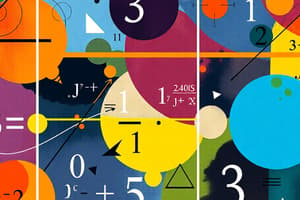Podcast
Questions and Answers
What distinguishes similar figures from one another?
What distinguishes similar figures from one another?
- They can be transformed into each other through rotation.
- They have the same shape but different sizes. (correct)
- They have the same size.
- They have different shapes but the same size.
What is a key characteristic of postulates in mathematics?
What is a key characteristic of postulates in mathematics?
- They represent hypotheses that must be tested.
- They are statements accepted as true without proof. (correct)
- They can be proven true or false.
- They are theorems that require proof.
Which of the following is NOT a type of equation?
Which of the following is NOT a type of equation?
- Exponential equation
- Scalar equation (correct)
- Quadratic equation
- Linear equation
Which symbol represents the concept of summation in mathematics?
Which symbol represents the concept of summation in mathematics?
Which field extensively uses mathematics for algorithms and data analysis?
Which field extensively uses mathematics for algorithms and data analysis?
What is the primary focus of algebra?
What is the primary focus of algebra?
Which number system includes both positive and negative numbers?
Which number system includes both positive and negative numbers?
What does the commutative property state about addition?
What does the commutative property state about addition?
What is the purpose of trigonometry?
What is the purpose of trigonometry?
Which of the following is true about real numbers?
Which of the following is true about real numbers?
Flashcards
Arithmetic Operations
Arithmetic Operations
Basic math operations: addition, subtraction, multiplication, and division.
Variables in Algebra
Variables in Algebra
Symbols (like 'x' or 'y') representing unknown values in equations.
Natural Numbers
Natural Numbers
Counting numbers (1, 2, 3, ...).
Commutative Property
Commutative Property
Signup and view all the flashcards
Geometry Shapes
Geometry Shapes
Signup and view all the flashcards
Similar Figures
Similar Figures
Signup and view all the flashcards
Theorem
Theorem
Signup and view all the flashcards
Postulate
Postulate
Signup and view all the flashcards
Linear Equation
Linear Equation
Signup and view all the flashcards
Mathematical Problem Solving Steps
Mathematical Problem Solving Steps
Signup and view all the flashcards
Study Notes
Branches of Mathematics
- Arithmetic deals with basic operations like addition, subtraction, multiplication, and division.
- Algebra uses variables to represent unknown quantities and solve equations.
- Geometry studies shapes, sizes, and positions of figures in space.
- Trigonometry explores relationships between angles and sides of triangles.
- Calculus involves concepts like limits, derivatives, and integrals, used in analyzing change and accumulation.
- Statistics deals with collecting, organizing, analyzing, and interpreting data.
- Probability studies the likelihood of events occurring.
Fundamental Concepts
- Sets are collections of objects.
- Functions relate input values to output values.
- Variables are symbols representing unknown quantities.
- Equations express equality between two expressions.
- Inequalities show that one expression is greater than, less than, or equal to another.
- Sequences are ordered lists of numbers.
- Series involve the sum of a sequence of numbers.
Number Systems
- Natural numbers (1, 2, 3, ...) are used for counting.
- Whole numbers include all natural numbers and zero.
- Integers include positive and negative whole numbers and zero.
- Rational numbers can be expressed as fractions.
- Irrational numbers cannot be expressed as fractions, like π (pi) and √2.
- Real numbers encompass all rational and irrational numbers.
- Complex numbers include real and imaginary numbers.
Operations
- Addition combines quantities.
- Subtraction finds the difference between quantities.
- Multiplication scales a quantity.
- Division distributes a quantity.
- Exponents indicate repeated multiplication.
- Roots relate to repeated division or multiplication.
- Order of Operations (PEMDAS/BODMAS): Parentheses/Brackets, Exponents/Orders, Multiplication/Division (from left to right), Addition/Subtraction (from left to right).
Properties of Numbers
- Commutative property: order doesn't matter for addition and multiplication.
- Associative property: grouping doesn't matter for addition and multiplication.
- Distributive property: multiplication distributes over addition.
- Identity property: adding zero or multiplying by one doesn't change a number.
- Inverse property: opposite operations cancel each other out.
Geometry Principles
- Shapes have different properties like area, perimeter, and volume.
- Euclidean geometry deals with flat surfaces.
- Non-Euclidean geometry deals with curved surfaces.
- Congruent figures have identical shapes and sizes.
- Similar figures have the same shape but different sizes.
- Theorems are statements that can be proven.
- Postulates are statements that are accepted as true without proof.
Mathematical Problem Solving
- Define the problem.
- Gather relevant information.
- Formulate a strategy.
- Solve the problem.
- Check the answer.
Applications of Mathematics
- Physics uses mathematics to model physical phenomena.
- Engineering uses mathematics to design and build structures.
- Computer science uses mathematics for algorithms and data analysis.
- Finance uses mathematics for investment strategies and risk management.
- Biology uses mathematics to model population growth and genetics.
Different Types of Equations
- Linear equations: represent straight lines on a graph.
- Quadratic equations: involve a squared term.
- Polynomial equations: include more complex terms.
- Exponential equations: involve exponents.
- Trigonometric equations: involve trigonometric functions.
- Logarithmic equations: involve logarithms.
Important Mathematical Symbols
- = (equals) symbol denotes equality.
-
(greater than) and < (less than) are used in inequalities.
- ≠ (not equal to) indicates inequality
- ± (plus or minus) signifies multiple possible values.
- √ (square root) extracts the square root of a value.
- π (pi) is the ratio of a circle's circumference to its diameter
- ∑ (sigma) indicates summation.
Studying That Suits You
Use AI to generate personalized quizzes and flashcards to suit your learning preferences.




